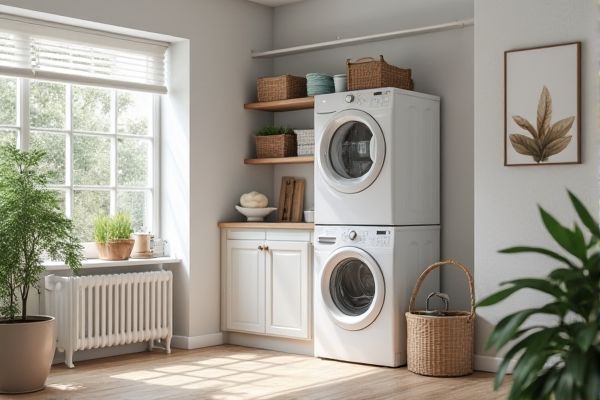
Laundry organizer towers maximize vertical space, offering multiple tiers for sorting and storing laundry essentials without occupying too much floor area. Compare these benefits with horizontal organizers to discover which layout best fits your space and routine--read on to find your ideal laundry solution.
Table of Comparison
| Feature | Laundry Organizer Tower | Horizontal Organizer |
|---|---|---|
| Design | Vertical, tall and narrow | Wide, low-profile layout |
| Space Efficiency | Optimizes floor space, ideal for small rooms | Requires more horizontal space |
| Storage Capacity | Multiple stacked compartments | Wide compartments, easy access |
| Accessibility | Easy to reach items on different levels | Items spread out, accessible at once |
| Mobility | Often sleeker, can fit through doorways easily | Bulkier, less portable |
| Best Use Case | Small spaces, apartments, closets | Laundry rooms with ample floor space |
Introduction to Laundry Organizer Solutions
Laundry organizer towers maximize vertical storage space, efficiently accommodating detergents, fabric softeners, and cleaning supplies within compact footprints ideal for small laundry rooms. Horizontal organizers offer spacious, accessible layouts perfect for folding areas, providing easy reach and organization for larger items and baskets. Choosing between vertical and horizontal designs depends on room dimensions, storage needs, and workflow preferences to optimize laundry area functionality.
Overview: Tower vs. Horizontal Organizers
Laundry organizer towers save space by stacking bins vertically, making them ideal for small rooms or tight corners. Horizontal organizers spread bins side-by-side, offering easier access and visibility for sorting laundry but require more floor space. Your choice depends on room layout and whether you prioritize compact storage or convenient sorting.
Space Efficiency Comparison
Laundry organizer towers maximize vertical space, making them ideal for small laundry rooms or apartments where floor area is limited. Horizontal organizers spread out across the room, requiring more floor space but offering easier access to items at a glance. Choosing between the two depends on room dimensions and storage needs, with tower units providing compact, stacked storage and horizontal units enhancing visibility and accessibility.
Storage Capacity and Accessibility
Laundry organizer towers maximize vertical storage capacity by utilizing height, making them ideal for small spaces with limited floor area. Horizontal organizers offer easier accessibility to items stored at waist or eye level, reducing the need to reach or bend frequently. Your choice depends on whether you prioritize compact storage or quick, convenient access to laundry essentials.
Installation and Setup Requirements
Laundry organizer towers typically require vertical space and secure anchoring to walls or closets for stability, making installation straightforward but dependent on wall strength and height clearance. Horizontal organizers need more floor space and often consist of modular units that can be assembled with basic tools, offering flexible placement but requiring careful measurement to fit under counters or between appliances. Choosing between the two depends on available space and ease of installation, with towers favoring vertical storage and horizontals providing accessible, spread-out compartments.
Design and Aesthetic Considerations
Laundry organizer towers offer a vertical, space-saving design that enhances small laundry rooms by maximizing floor area and creating a sleek, modern look. Horizontal organizers provide a traditional, spread-out layout ideal for larger spaces, allowing easier access to multiple compartments while contributing to a balanced aesthetic. Choosing between tower and horizontal designs depends on available space and desired visual impact within the laundry area.
Durability and Material Quality
Laundry organizer towers typically feature sturdy metal or high-density plastic frames designed to withstand heavy loads and frequent use, offering superior durability compared to many horizontal organizers. Horizontal organizers often use fabric bins or lightweight materials that may wear out faster, especially under constant weight and moisture exposure. Choosing a tower made from reinforced steel or durable polypropylene ensures long-lasting performance and resistance to rust or mildew, critical for laundry room environments.
Usability for Different Laundry Spaces
Laundry organizer towers maximize vertical space, making them ideal for small or narrow laundry rooms where floor area is limited. Horizontal organizers provide wider, accessible surface areas perfect for spacious laundry rooms or folding stations, enhancing usability for sorting and storing clothes. Your choice depends on optimizing space efficiency and workflow based on your laundry room's dimensions.
Price and Value Analysis
Laundry organizer towers generally have a higher upfront cost due to their vertical design and space-saving features, offering significant value for small laundry rooms or apartments. Horizontal organizers tend to be more affordable but take up more floor space, which may reduce their overall practicality and value in compact areas. Evaluating the price against available space and specific storage needs helps determine which organizer provides the best cost-to-functionality ratio.
Choosing the Right Laundry Organizer for Your Needs
Laundry organizer towers maximize vertical space, making them ideal for small rooms or tight laundry areas where floor space is limited. Horizontal organizers provide easier access to items at a glance and typically offer more surface area for folding or sorting clothes. Selecting the right laundry organizer depends on your room size, storage needs, and preference for accessibility versus space-saving design.
 homyna.com
homyna.com